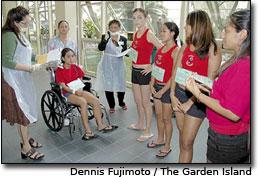LIHU’E — Kaua’i High School cheerleaders had a variety of symptoms when they arrived in the parking lot of Wilcox Memorial Hospital recently. Their arrival signaled the start of another phase of an emergency-preparedness exercise by hospital leaders, this drill
LIHU’E — Kaua’i High School cheerleaders had a variety of symptoms when they arrived in the parking lot of Wilcox Memorial Hospital recently.
Their arrival signaled the start of another phase of an emergency-preparedness exercise by hospital leaders, this drill revolving around the hospital staff’s response to a mass chemical spill.
“We do this once or twice a year,” one of the hospital security guards said. “Sometimes it involves mass casualties, but this time it’s chemical.”
The scenario, however, was not one of a spill, but involved a spray plane dousing the pepsters with an unknown chemical during members of the squad’s outdoor practice.
Each of the red-shirted pepsters donned a contrasting green card that labeled each individual’s symptoms.
They were whisked off to various stations throughout the hospital after being assessed by medical technicians at a triage area set up outside the hospital’s emergency room.
In anticipation of other victims, similar stations were set up at various entrances to the hospital.
Adding an element of realism to the scene, a pair of cheerleaders, also donning green symptom cards, wandered throughout the different arenas, unnoticed by the security or other personnel that manned the different stations.
Bothered, the pair stopped off at the mini operations center, where they were told to keep wandering until they were “discovered.”
The lobby had been swept clear of its furniture and planters, with the conference rooms being set up as holding areas, and the main conference room established as a center of operations.
A decontamination center had to be established, and based on the wind direction and speed, the initial site between the ER and lobby had to be relocated to a site behind the hospital’s dietary department, to prevent downwind contamination.
Once preliminary assessment was done, members of the affected groups were either trooped off to a secondary admitting station set up immediately inside the lobby, with “more serious” cases wheeled inside the emergency room.
“I just want you to know that if this was the real thing, you would be asked to the back of the hospital,” a security guard reminded a member of the media.
In the lobby, another station had more detailed examinations being done, with less-severe cases being led into a holding area, where the pepsters were observed for 30 minutes before being discharged.
During this observation time, a pharmacist dropped in to make sure no medications were necessary, as hospital leaders scurried between transporting patients, working medical teams, and dealing with observers from the county’s fire and police departments as well as the Civil Defense office.
It was only after everything was done to the leaders’ satisfaction that the announcement to conclude the exercise was made from the mini base of operations.
That signaled another round of activity, as staff members descended on the cleared furniture and planters to restore the lobby to its normal state, while the cheerleaders, converging from the different points in the hospital, were greeted with a cart bearing juice and cookies.
October is National Preparedness Month as proclaimed by Mayor Bryan J. Baptiste several weeks ago.


